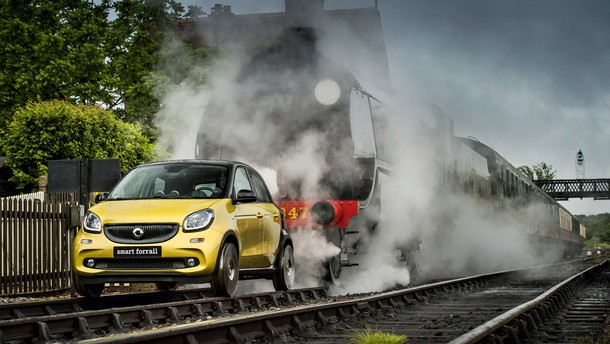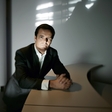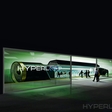

For the millions of commuters using trains day in, day out this is not big news: to get to the Goodwood Festival on June 27, the best way to avoid tremendous traffic congestion is to trade public roads for the British national railways, aboard a very special train: the Forrail, a Smart car transformed into a train that even requires a ticket.
The Goodwood Festival is held annually in West Sussex, about 150 km southwest of London, and the growing success that it has experienced, year after year, has turned the trip to this unique celebration of motorsports into a real nightmare. Thousands of people flock to the property of Lord March on each of the 3 days of the event, using the few roads available. That only a handful of hotels exist in the area certainly does not make it easier.

Inspired by the Smart brand tradition of making journeys in the city quicker and more convenient, the German brand partnered with the train manufacturer, Interfleet, to turn a Smart forfour into this Forrail. Used to working on 70 ton diesel locomotives, with 16 liter displacement engines (far more than the forfour, which weighs 1000 kilos and is propelled by a 999 cc engine), the British company, headquartered in Derby, faced this challenge with a smile and a lot of determination. Six months later, the Mercedes-Benz Group vehicle, which sought to realize the cinematographic fantasy that Roger Moore, as agent 007, simulated with a Mercedes 250 SE, was born: the rubber tires were replaced by massive 22" steel wheels, each weighing no less than 80 kilos (the only way to ensure that this unique Smart would not go off the rails). The steering wheel was disconnected from the wheels, to prevent undesired turning, and their structure was welded to the axes mounts.

In order to be eligible for this fun and unusual experiment, the Forrail even had to receive certification as a train, and to get onboard, the passengers had to purchase a ticket for this 18 km trip, which was divided into three sections (some 6 km each): from East Grinstead to Kingscote stations, followed by Horsted Kenes and, finally, Sheffield Park, using the Bluebell line, the oldest private railway line in Britain, which inspired the author of the children's book, "Thomas and his Friends," and whose station was used for the British TV series, "Downtown Abbey."

Each segment of this highly unusual trip was done with two journalists onboard, along with a train expert/machinist as a qualified back-up support, should a problem occur. The Bluebell line is currently used to recreate 19th and 20th century railway trips, during which visitors are able to stop at various locations to learn about monuments, gardens, or even the impeccably-restored train stations, where volunteers dress up to help to turn back the clock. The first section of this line was inaugurated on August 1, 1882 (133 years ago), and the locomotives were electrified in 1935, but the line was officially closed by 1963. Not many years went by before some of the discontinued railway sections were reactivated, but only in the 90s did these trips to the past begin to be conducted on a regular basis, and over greater distances. Finally, in March 2013, the line fulfilled its goal of being connected to the national railways of the United Kingdom (although most of the rails, and all the steam locomotives, are used only for tourism purposes).

In this bucolic setting, and with such a rich historical background, I was lucky enough to be chosen as a driver for the Smart Forrail locomotive, on one of the three segments of the journey. An even greater responsibility, considering that this would be the final section before the trip concluded in Sheffield. After being cleared by the ticket inspector, I sat behind the wheel of this forfour disguised as a Forrail, with the real machinist by my side, providing valuable tips to this rookie. Switch on the ignition, shift to 1st and release the clutch as smoothly as possible, while gently accelerating to the recommended speed of 8 km/h. Then it was necessary to increase the pace up to 35 km/h, a cruising speed which would prevent wheel deviation from the rails, and allowed this "train" to be on time. This would most likely avoid a cartoon situation of an angry mammoth locomotive chasing us at the entrance of a tunnel or, even worse, facing off against us inside one. It is so much better to leave cartoon scenarios to the miserable coyote at the mercy of the merciless roadrunner...

No matter how many times the instructor would tell me "you may take your hands off the steering wheel," the truth is that, over the first kilometer, I was not able to let it go, as if I were actually in charge of keeping the car-turned-train on the rails. Finally I managed to use some of the experience gained when (not) driving autonomous driven prototypes, to drop the otherwise very valuable interface, and was able to focus only on the few gear changes I had to perform, and the smoothness with which I stepped on the accelerator. One of the most striking sensations I came back with was undoubtedly the familiar sound of the heavy wheels on the rails' junctions, exactly the same that we hear on any ordinary train trip... and this is how it dawned on me how good the train´s soundproofing materials must be, although the tiny Smart struggled to achieve such good results, simply because my ears were much closer to the rails than they would be on a train.

Other solemn moments included going over the rails' intersections and, best of all, the pomp and circumstance of arrival at the main station, where I decided to draw the attention of visitors by emphatically horning the honk, which is specifically used on the Smart Forrail for this purpose (honky-honky). At first they were halfway between scared and incredulous, but quickly reconciled to the sight, and rushed in our direction, pin-pointing their camera phones at the Lilliputian Chattanooga-choo-choo, to record the historic moment...

At the end of the day, the Forrail proved that, just like its road counterpart, it is well capable of speeding up any A to B trip that otherwise would take hours to be completed on heavily congested roads. Truly a "smart" solution for the increasingly packed accesses to and from the mega-cities of the future.


